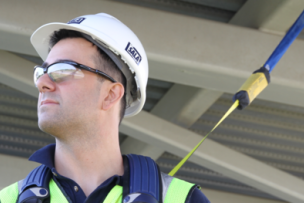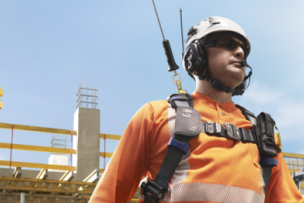Narrator: Welcome to Tooling Up, a series by MSC Industrial Supply Company that provides real-world insights brought to you by leading industry experts and aimed at improving the efficiency and productivity of your operations.
Eddie: Hey everybody, this is Eddie with MSC and welcome to this episode of MSC's Tooling Up featuring Master Lock. On today's episode we're going to talk about the proper procedures and importance of lockout and here to tell us everything that we need to know, we brought in our good friend from the team at Master Lock, Bill. Let's bring him on in. Hey Bill, thank you so much for joining us on today's episode of MSC's Tooling Up. Before we get started why don't you tell us a little bit about yourself and what you do for the team at Master Lock?
Bill: Hey Eddie, thanks for having me I appreciate the opportunity here. I have over 20 years of safety management experience and lockout has been always an important aspect when you're talking about safety management here in the United States and working with organizations all over the world and then coming here to Master Lock as the safety services program manager helping organizations make sure that their lockout management system is second to none.
Eddie: Wonderful, well thank you so much for joining us on today's episode. So now that we're here, let's get started. So today we're going to be talking about many things regarding lockout, but let's get things kicked off. Why lockout Bill? What do you have for us?
Bill: Why lockout? It's simple. We want to make sure that our employees go home the same way that they came during that day. Safety is of the utmost importance. We want to recognize hazardous energy when we're conducting service and maintenance on equipment to ensure that safe working environment and not only from a safety perspective but we do have to consider there are legal ramifications in this as well. It is law, so locking out equipment while servicing maintenance is a legal responsibility by all organizations and employees that are conducting those activities.
Eddie: Interesting Bill, so why are we required to lock out?
Bill: Well, we're required because of so many incidents and fatalities that do occur as people are conducting these servicing maintenance activities whether it's changing filters you know, unjamming product, and all these different activities in a machine, making sure that any energy that is used to make that machine run that that's shut off and when it isn't those machines can be very unforgiving and have a high prevalence of injuries and fatalities. And that's why it is such a big part of OSHA's charge to make sure that they are holding employers accountable to the lockout standard.
Eddie: Hey, this makes sense Bill. So within an organization, who really needs to be concerned with the lockout procedure?
Bill: Yeah that's a great question and we work with a lot of organizations and companies that feel that maybe it's just those that actually are locking equipment out that should be concerned, but all of the employees within an organization need to understand their responsibilities from management being able to support those lockout activities all the way down to those that may be working in and around a lockout activity but actually aren't doing that. They need to be educated too to make sure that they are not tampering with any lockout scenario or getting close to a machine that is in a locked out state. So, everybody within an organization needs to understand their role and responsibility within lockout.
Eddie: This makes sense and what type of standards would you say exist within a proper lockout procedure?
Bill: Yeah, that's a great question and you know simply stated it's 1910-147, OSHA 1910-147. That is the law and I encourage all employers to make sure that they are conforming to those standards first. Now there is another standard, ANSI Z244.1, the control hazardous energy standard, that a lot of organizations do take a look at guiding their lockout activities. But before they get to that standard and looking for alternative methods to lockout, they need to make sure, we need to make sure, that they're conforming to that 1910-147 standard specifically with their lockout procedures.
Eddie: So if I'm a company that's trying to optimize my lockout procedure, what challenges may I see?
Bill: The challenges that we see a lot of time is in the actual recognition of that hazardous energy. So many times we may see a lockout procedure that just has electrical or electricity within that lockout procedure but there are other hazardous energies that need to take in consideration. It could be thermal energy, it could be gravity. There's a lot of pieces of equipment within machines that could come down as a result of shutting them up. Gravity is a big one that we see a lot of times. So the challenge I think is the actual recognition of all the hazardous energy that goes to make that machine run and then capture that in that step-by-step document of that lockout procedure.
Eddie: What are some ways that an organization can navigate and address these challenges?
Bill: I think it's all about training. Understanding the law from the management standpoint. What are their responsibilities? Do we kind of take a look at hierarchy controls, you know, kind of going down the line when we're looking at lockout. We always want to engineer something out. Well we do have to service and maintain equipment so we really can't stop that from happening. Substituting that is kind of the next way to eliminate hazards but that also doesn't work that great. So when we're talking about lockout, we're always looking at lockout as an administrative control. And when we're talking about administrative controls, we're talking about making sure that us humans, who are not perfect, have proper training and understanding on how to lock a piece of equipment out. What procedures are necessary? The training and the policy as well within an organization to make sure that they're covering all their bases. So I think really training is the big component of this to make sure everybody understands their role.
Eddie: Absolutely and so Bill, today's episode we have really covered some ground, so if you wouldn't mind giving us a quick recap of everything we've covered today.
Bill: Yeah absolutely. I think it all starts with 1910-147, the OSHA standard. Making sure that we understand where that applies to our servicing and maintenance. I think, too, understanding what equipment we're locking out, who's locking that out, making sure that we have the proper lockout procedures to get that to a zero energy state and once we have those procedures obviously we need to make sure everybody's trained and understanding how to apply and implement those procedures that have been written. But we're not done there. Once we have those procedures in place, there's always that annual review that takes place. So you're not done once the procedures are established. We need to annually review and make sure that we're capturing any changes that occur within our processes or the equipment too, so that annual auditing is such a key aspect of lockout to maintain that safe working environment.
Eddie: And for those who want to learn more about not only the wonderful things we've discussed today, but to also learn about all the other wonderful things that Master Lock is bringing to the industry, where can we get more information?
Bill: It's easy website–mscdirect.com/masterlock–you can find all the information you need for us to help you and your lockout management system.
Eddie: Wonderful. Hey thank you so much for your time, energy, and expertise today on this episode of MSC's Tooling Up featuring Master Lock.
Narrator: Want more insights and ideas to improve the efficiency and productivity of your operations? Check out the Tooling Up video playlist to see how we can improve your operations and subscribe to our channel so you never miss out.




Talk to Us!
Leave a reply
Your email address will not be published. Required fields are marked *